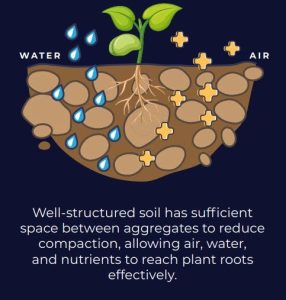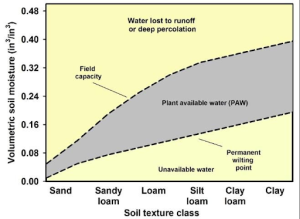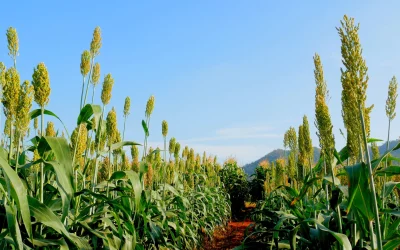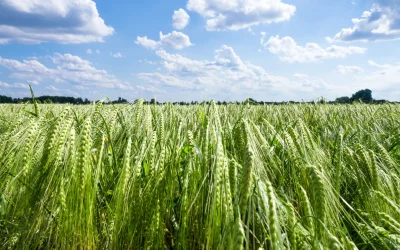Insufficient moisture is a common yield-limiting factor that many farmers face each season. While you can’t control the weather, you can take steps to improve the water-holding capacity of soil to make the most of the moisture you do get. Let’s explore the factors that influence soil water-holding capacity and steps you can take to manage soil moisture more effectively.
Fundamentals of Soil Water Holding Capacity
Water holding capacity is the amount of water the soil can retain after excess water has drained. It is primarily influenced by a soil’s texture, structure and organic matter content.

Soil texture refers to the proportion of sand, silt and clay particles of a soil. Sandy soils have larger particles with less surface area, limiting water-holding capacity. Silt and clay soils are comprised of smaller particles with a larger surface area that aids in water retention. Well-balanced loam soils contain just the right amount of sand, silt and clay particles to support good drainage and water retention. Soil texture is a fixed characteristic, and there is not much you can do to change the particle size of your soils.
Soil structure refers to how soil particles are arranged to form aggregates. The spaces between soil aggregates are essential for water and air movement and influence water-holding capacity. Soil structure can be influenced by the climate, soil type, compaction and biological activity – therefore, you can improve it with thoughtful management practices.
Soil organic matter consists of decaying material that originated from a living organism. Organic matter acts like a sponge in the soil to help retain moisture; therefore, higher organic matter means more water-holding capacity. A report by the University of Minnesota states that increasing organic matter by just 1% increases available water capacity in the soil by about 3,400 gallons per acre in a medium-textured soil.1
Other factors, including air temperature and precipitation, can impact a soil’s water retention capabilities. Higher temperatures can reduce water’s surface tension, limiting the soil’s ability to hold water.
Water-holding Capacity and Plant Health
A soil’s water-holding capacity directly impacts plant health because it determines how much water is available to plants between rainfall or irrigation events. A soil with greater water-holding capacity is better suited to sustain a plant’s moisture needs in the absence of additional moisture via rainfall or increased irrigation. That means less crop stress when the rain stops and less irrigation required to maintain plant health throughout the season. Improving water-holding capacity is one way to limit drought stress and the adverse yield effects that come with it.
Field Capacity and Permanent Wilting Point
Field capacity and permanent wilting point are terms used to describe the limits of water storage in the soil. The chart below shows that field capacity is the upper limit of water storage in the soil. It represents the maximum amount of water a soil can hold against gravity after a significant rainfall or irrigation event.
The permanent wilting point is the lower water storage limit in the soil. When soil moisture reaches this point, plants can no longer absorb water from the soil and yield loss is an imminent risk.
Generally, the amount of water available to plants will fall between the permanent wilting point and field capacity. The amount of plant-available water influences irrigation schedules, since most farmers look to maximize efficiency by irrigating enough to adequately meet plant demands without exceeding field capacity.

Applications and Management Implications
Now that you know more about the factors influencing a soil’s water-holding capacity, you may wonder how to improve moisture management. While some variables, such as weather conditions and soil texture, are largely out of your control, the following actions can help improve water retention in your fields.
Know Your Soil
It’s simple advice, but the more you know about your soil, the better you can manage it. The water-holding capacity of your soil should influence how you manage moisture and schedule irrigation events. Coarse-textured, sandy soils drain rapidly and have a low water-holding capacity. More frequent irrigation is required for these soils to meet a crop’s developmental needs. Fine-textured soils, such as clays and silts, have a higher water-holding capacity and require less frequent irrigation than sandy soils.
Plan to adjust irrigation schedules based on environmental conditions, crop uptake, rooting depth and field capacity. Irrigation technology, including soil moisture sensors, can provide real-time data to help guide greater irrigation efficiency.
Build Organic Matter
Increasing soil organic matter is one of the best ways to improve moisture retention and soil health. Organic matter helps create more stable soil aggregates for holding water and reduces runoff potential. Practices such as conservation tillage, planting cover crops, applying manure and rotating crops can add essential organic material to the soil.
While building organic matter in the soil takes time, the agronomic benefits are cumulative. Soil organic matter not only improves moisture retention but also fuels beneficial soil microbes, improves nutrient cycling and helps deliver more consistent yields year over year. A report from the USDA’s Natural Resources Conservation Services estimates that the total long-term value of a 1% increase in soil organic matter is $29 per acre for the additional nutrient value and available water holding capacity it provides.2*
Make the Most of Your Water
One management practice you may not have considered is how your irrigation water’s properties can influence soil moisture distribution, retention and plant uptake. Characteristics, including surface tension and structure, directly affect water use efficiency.
Water has a high surface tension compared to other liquids, allowing it to form droplets, which is essential for rain formation. However, when it comes to distributing water evenly through the soil, less surface tension is better. That’s because a lower surface tension allows water to spread and disperse, resulting in more consistent moisture across and into the soil profile.
Similarly, water’s organization can impact how it is retained and taken up from the soil. Studies show that irrigation water with a more organized structure significantly increased water use efficiency in cowpea crops, compared to irrigation with regular tap water.3 Those water use benefits translate to agronomic advantages, with studies showing that sugar beets irrigated with organized water had significantly higher quality and wheat produced higher yields.4,5
You can achieve these water-enhancing benefits with TerraFlow® by UpTerra. The plug-and-play device installs into most irrigation systems and uses two patent-pending technologies – vortexing and frequency transmission – to enhance water’s organization and reduce its surface tension.
TerraFlow improves moisture movement and distribution in the soil compared to untreated irrigation water, ensuring crops have more plant-available water at key growth stages. More consistent moisture distribution contributes to better root growth, enhancing a plant’s access to moisture and vital nutrients. TerraFlow also improves moisture retention in the soil, potentially reducing the number of irrigation events required to meet crop demand throughout the season.
TerraFlow is installed on over 40,000 acres across the U.S. and Mexico, helping growers overcome production challenges that have historically limited productivity. Benny Froese, a row crop and livestock farmer in New Mexico, says, “The proof is in the pounds. Visually, my silage crop didn’t look much different from my neighbor’s, but my yield was way higher at harvest. That’s what TerraFlow gave me.”
Interested in learning how TerraFlow can improve water-holding capacity on your acres? Request our water use efficiency benefits report, or contact us to reach a local UpTerra representative.
*These estimates are based on Iowa’s annual average of 34 inches of precipitation. Actual results will vary based on precipitation amounts and intensity, starting soil health conditions, crop rotation, and tillage methods selected.
References
- University of Minnesota. The connection between soil organic matter and soil water. 2024. Online.
- USDA-NRCS. Value of soil health. Online.
- Sadeghipour O, Aghaei P. Improving the growth of cowpea (Vigna unguiculata L. Walp.) by magnetized water. Journal of Biodiversity and Environmental Sciences (JBES). 2013; 3(1):37-43.
- Hozayn M, Abd El Monem AA, Abdelraouf RE et al. Does magnetic water affect water use efficiency, quality and yield of sugar beet (Beta vulgaris L.) plants under arid conditions?. Journal of Agronomy. 2013; 12(1):1-10.
- Hozayn M, Abdul Qados AMS. Magnetic water application for improving wheat (Triticum aestivum L.) crop production. Agriculture and Biology Journal of North America. 2010b; 1(4):677-682.




